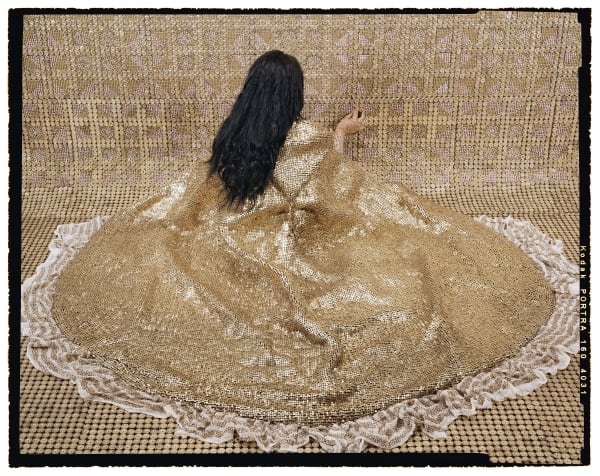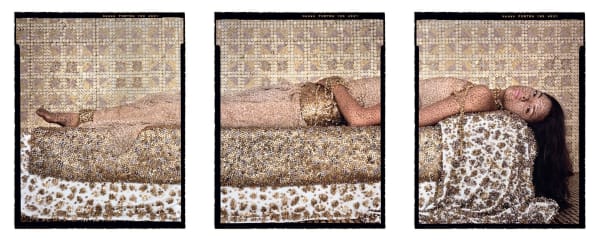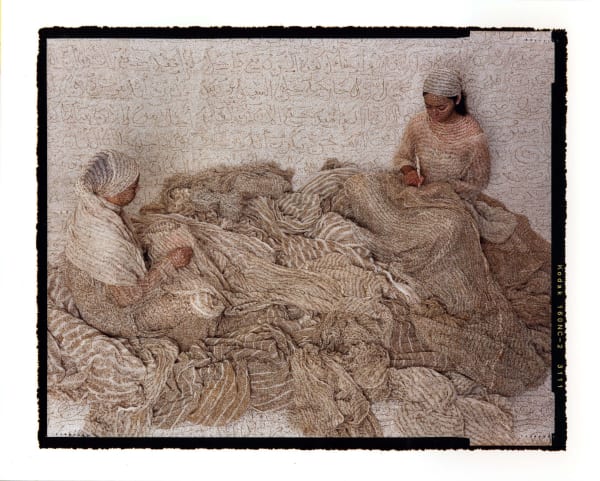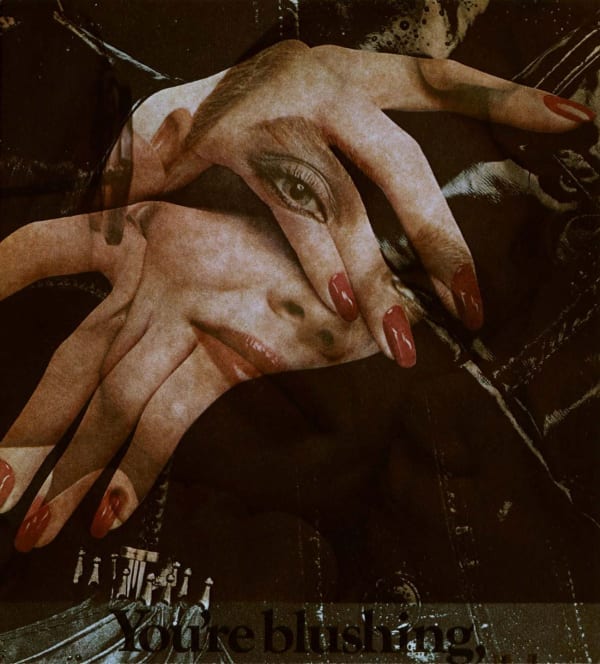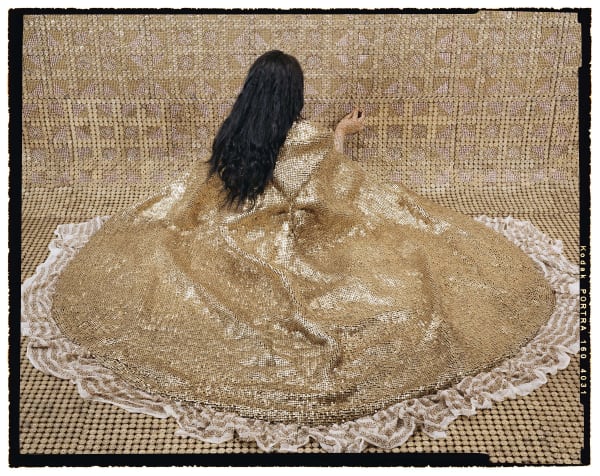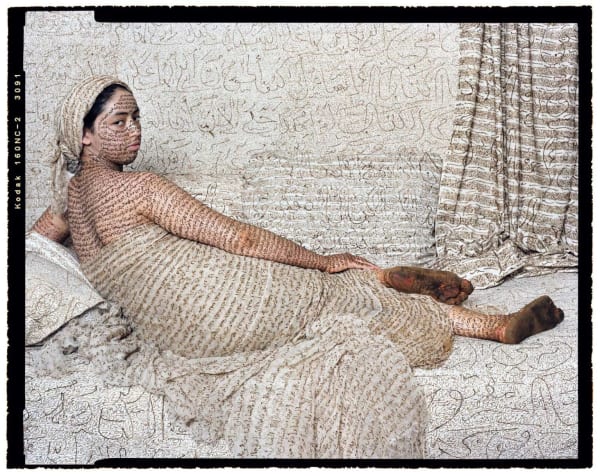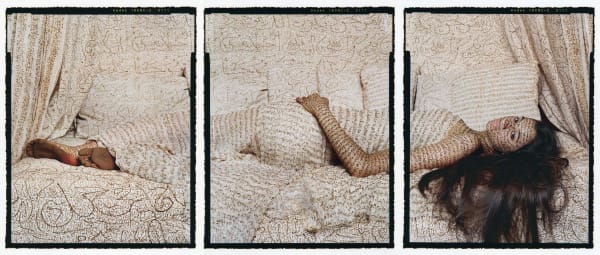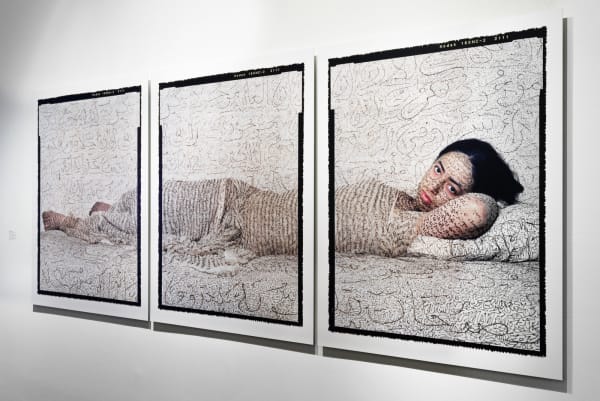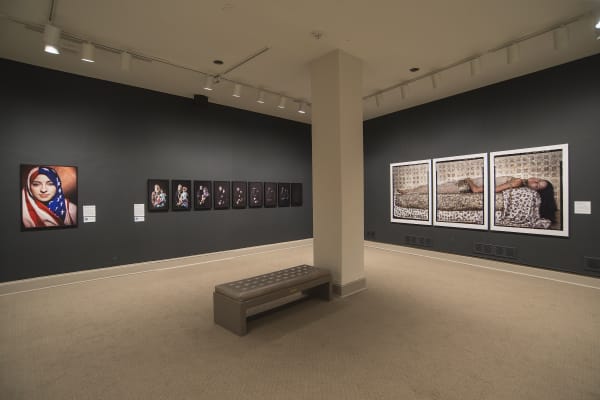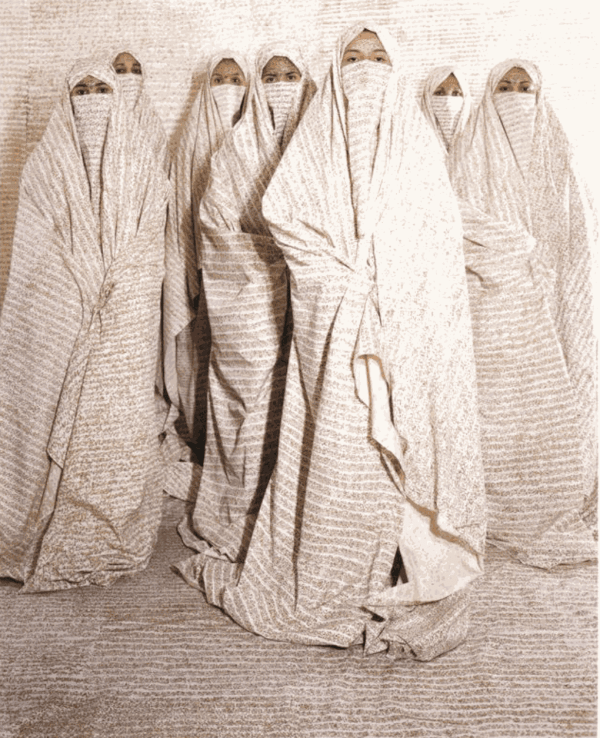Lalla Essaydi
Lalla Essaydi’s art champions women. Central to the artist’s vision is a unique synthesis of personal and historical catalysts. As a Muslim woman who grew up in Morocco, raised her family in Saudi Arabia, and relocated to France and finally the United States, the artist has profound firsthand perspectives into cross-cultural identity politics. Weaving together a rich roster of culturally embedded materials and practices—including the odalisque form, Arabic calligraphy, henna, textiles, and bullets—she illuminates the narratives that have been associated with Muslim women throughout time and across cultures. By placing Orientalist fantasies of Arab women and Western stereotypes in dialogue with lived realities, Essaydi presents identity as the culmination of these legacies, yet something that also expands beyond culture, iconography, and stereotypes.
The performative act of inscribing women’s bodies and spaces with calligraphy is a vital part of Essaydi’s approach, emphasizing the ongoing, active, and collaborative process of becoming and creating. Since her first major series Converging Territories (2002-4), Essaydi has used henna to envelope the women in her photographs in Arabic calligraphy, a skill she could not learn in school due to her gender. Henna is a form of decoration that marks some of the happiest and most significant moments of a Muslim woman’s life, and Essaydi elevates this tradition—conventionally regarded as a “woman’s craft”—into a radical act of visual and linguistic artistry. The stream-of-consciousness, poetic script includes biographical details relating to the artist’s and models’ experiences as women. Essaydi’s series Les Femmes du Maroc (2005-7) continued to engage with these approaches while expanding to also question the historical representation of Arab women in the Western art canon, referencing the Orientalist imagery of 19th century artists such as Ingres, Delacroix, and Gérôme. Her reinterpretation is a strong statement of the power of artistic representation to influence identity. In her Harem series (2009), set in a lavish yet isolating harem in Morocco, Essaydi addresses the complex social and physical confines of Muslim womanhood. Her most recent series Bullets (2009-14) introduces a new material for the artist, silver and gold bullet casings, which she has woven to create glittering gowns of armor.
Essaydi’s work deliberately incorporates and invites perspectives from many angles. “In my art,” Essaydi explains, “I wish to present myself through multiple lenses—as artist, as Moroccan, as traditionalist, as Liberal, as Muslim. In short, I invite the viewer to resist stereotypes.”
Essaydi spent her most foundational years living in traditional Muslim society in Morocco and Saudi Arabia. She attended École nationale supérieure des Beaux-Arts in Paris before earning her BFA from Tufts University and MFA from the School of the Museum of Fine Arts, both in Boston. Her work has been exhibited around the world, including at the San Diego Museum of Art, CA; Museum of Fine Arts, Boston, MA; Bahrain National Museum; and Sharjah Calligraphy Biennial, United Arab Emirates. Essaydi’s work is represented in the collections of the Los Angeles County Museum of Art, CA; Art Institute of Chicago, IL; Museum of Fine Arts, Houston, TX; National Gallery of Art, Washington, D.C.; Brooklyn Museum of Art, NY; Museum of Fine Arts, Boston, MA; and the Louvre Museum, Paris, amongst many others. The artist currently lives in Boston and Marrakesh.
-
 Lalla EssaydiBullets Revisited #20, 2013
Lalla EssaydiBullets Revisited #20, 2013 -
 Lalla EssaydiBullets Revisited #3, 2012
Lalla EssaydiBullets Revisited #3, 2012 -
 Lalla EssaydiBullets Revisited #47B, 2017
Lalla EssaydiBullets Revisited #47B, 2017 -
 Lalla EssaydiConverging Territories #30, 2004
Lalla EssaydiConverging Territories #30, 2004 -
 Lalla EssaydiConverging Territories #40, 2004
Lalla EssaydiConverging Territories #40, 2004 -
 Lalla EssaydiConverging Territories: Apparel #6, 2003
Lalla EssaydiConverging Territories: Apparel #6, 2003 -
 Lalla EssaydiDancer #10, 2009
Lalla EssaydiDancer #10, 2009 -
 Lalla EssaydiHarem #14B, 2009
Lalla EssaydiHarem #14B, 2009 -
 Lalla EssaydiHarem #2, 2009
Lalla EssaydiHarem #2, 2009 -
 Lalla EssaydiHarem Revisited #33, 2012
Lalla EssaydiHarem Revisited #33, 2012 -
 Lalla EssaydiHarem Revisited #59, 2013
Lalla EssaydiHarem Revisited #59, 2013 -
 Lalla EssaydiLes Femmes du Maroc #1, 2005
Lalla EssaydiLes Femmes du Maroc #1, 2005 -
 Lalla EssaydiLes Femmes du Maroc: Fumée d’Ambre Gris, 2008
Lalla EssaydiLes Femmes du Maroc: Fumée d’Ambre Gris, 2008 -
 Lalla EssaydiLes Femmes du Maroc: Harem Beauty #2, 2008
Lalla EssaydiLes Femmes du Maroc: Harem Beauty #2, 2008 -
 Lalla EssaydiLes Femmes du Maroc: Harem Women Writing, 2008
Lalla EssaydiLes Femmes du Maroc: Harem Women Writing, 2008 -
 Lalla EssaydiLes Femmes du Maroc: La Grande Odalisque, 2008
Lalla EssaydiLes Femmes du Maroc: La Grande Odalisque, 2008
-

Summer 2025 Group Show 'Heatwave' in Musée Magazine
Exhibition Review 22 July 2025Musée Magazine spotlights the exhibition Heatwave , on view at Edwynn Houk Gallery through July 25. The show brings together works by Lillian Bassman, Sally...Read more -

Lalla Essaydi: L'invisible dévoile
Musée des Confluences Dar El Bacha 1 October 2024Lalla Essaydi's exhibition L'invisible dévoilé is on view at the Musée des Confluences Dar El Bacha in Marrakech, in the same historic palace where the series Harem was made in 2009.Read more -

Arab Female Identity in Lalla Essaydi’s Exhibition, Image and Text
The New Arab 20 May 2022Moroccan artist Lalla Essaydi appropriates traditionally male Islamic art practices and motifs with European Orientalist paintings to illuminate an otherwise stagnant image of the exotified...Read more -

Lalla Essaydi at the Patricia & Phillip Frost Art Museum
Lalla Essaydi: Image and Text 7 May 2022On View 7 May — 7 August 2022 Lalla Essaydi creates meticulously staged photographs that deconstruct and reimagine stereotypes of Arab women. Her subjects’ bodies...Read more -

A Multi-Layered Perspective
Review of A New Gaze in Aesthetica Magazine 28 April 2022A woman reclines, her body twisted away from us, face turned towards the lens. To those with a background knowledge of European art history, her...Read more -

Exhibitions by Arab Artists in NYC on the Present and Future of Middle Eastern Life
Lalla Essaydi in The Observer 14 April 2022Lalla Essaydi’s “A New Gaze,” on show at Edwynn Houk Gallery, also ambitions to break away from externally-imposed constraints. In her body of work, Essaydi...Read more -

Lalla Essaydi's Work Featured in Elle Decor
Jan/Feb 2021 Cover Feature 5 January 2021“We live in a city that is filled with artists and talent and creativity, and we wanted to harness that in our home,” the owner of a Carnegie Hill apartment says.Read more -

Women artists of the Middle East: seven names to know
Lalla Essaydi highlighted by Christie's 5 November 2020The work of artist Lalla Essaydi has been acclaimed across the globe.Read more -

Women’s Art Is Every Kind of Art
Lalla Essaydi in the New York Times 12 March 2020“Women Take the Floor,” an exhibition at the MFA Boston through May 3, 2021, features 200 mixed-media works by more than 100 women over the past century.Read more -

Women’s Art Is Every Kind of Art: Review of MFA Boston Exhibition
LALLA ESSAYDI IN THE NEW YORK TIMES 12 March 2020In the photography gallery, rotating works by the Moroccan-born artist Lalla Essaydi incorporate Islamic calligraphy, a sacred art form dominated by men in part because...Read more -

Inspired By The East: How The Islamic World Influenced Western Art
LALLA ESSAYDI FEATURED IN EXHIBITION AT THE BRITISH MUSEUM 16 July 2019Inspired by the east: how the Islamic world influenced western art charts the long and complex cultural interactions between Europe and North America in the...Read more -

Arab Women Take Back Their Images in Art
Lalla Essaydi in the New York Times 18 March 2017A panel discussion at The New York Times Art for Tomorrow conference in Doha explored the subject of how Arab women are portrayed in art, with Lalla Essaydi, an artist who lives and works in New York and Marrakesh, and Touria El Glaoui, the founder of the 1:54 Contemporary African Art Fair and the daughter of the renowned Moroccan painter Hassan El Glaoui.Read more -

At LA Museum, A Powerful And Provocative Look At 'Islamic Art Now'
Lalla Essaydi on NPR 5 May 2015Islamic Art Now: Contemporary Art of the Middle East is indeed about beauty. It's also about values, religion and a clash of cultures. And its provocative, dramatic, powerful images linger in the mind.Read more -

A Show of Strength by Middle Eastern Women Photographers
"She Who Tells a Story" at the MFA Boston in the New York Times 26 August 2013“She Who Tells a Story,” which includes work by women artists from the Middle Eastern region including by Lalla Essaydi, opens at the Museum of Fine Arts in Boston this week.Read more -

“My work is really my history”
Lalla Essaydi at the Smithsonian’s National Museum of African Art (Washington Post) 9 May 2012“My message would be: Arab women are not so much oppressed as the Western World thinks. We are women incredibly engaged in our lives, to have a better life,”artist Lalla Essaydi said Tuesday, as she toured her exhibit, “Lalla Essaydi: Revisions,” which opened Wednesday at the Smithsonian’s National Museum of African Art.Read more -

National Museum of African Art Presents “Lalla Essaydi: Revisions”
Boundary-Pushing New Works by Lalla Essaydi Featured in Exhibition 10 April 2012Lalla Essaydi, one of today’s most provocative and engaging visual artists, is the focus of a multimedia exhibition at the Smithsonian’s National Museum of African Art.Read more -

Reviving the Exotic to Critique Exoticism
Lalla Essaydi in the New York Times 5 March 2010“Lalla Essaydi: Les Femmes du Maroc,” an exhibition at the Jane Voorhees Zimmerli Art Museum, draws attention to one of the most interesting if puzzling developments in contemporary art: a revival of exotic, often historical imagery of people from faraway places in the name of a critique of exoticism.Read more -

Re-Inventing the Spaces Within
Lalla Essaydi in Aperture 1 March 2005Lalla Essaydi published in Aperture Magazine.Read more

